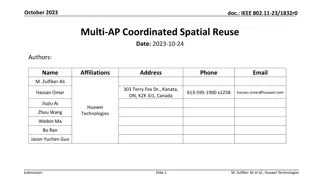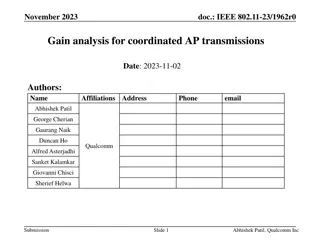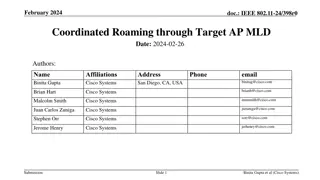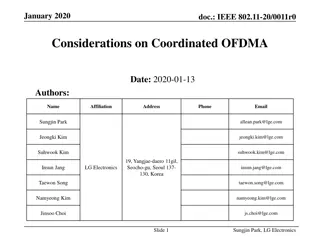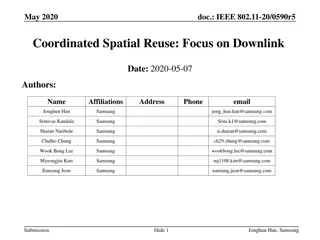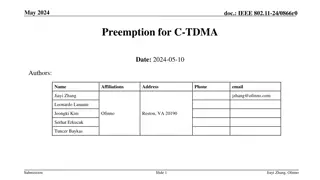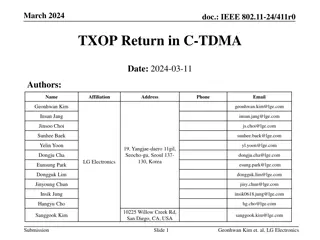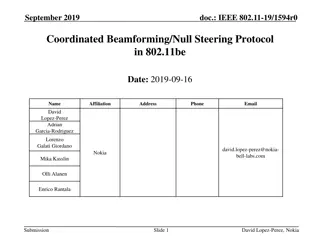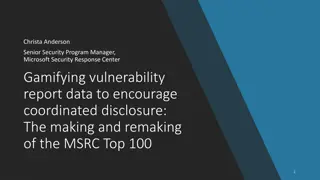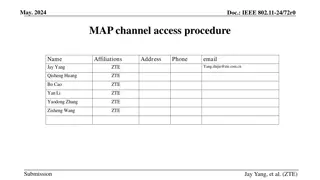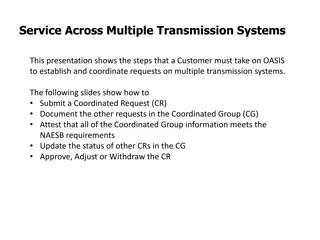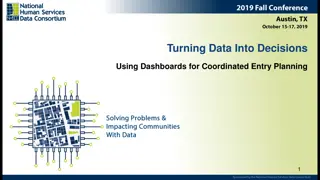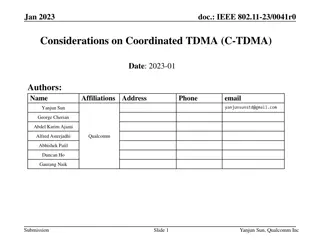
Coordinated TDMA in IEEE 802.11-24: Considerations and Framework
"Explore the framework for Coordinated TDMA in IEEE 802.11-24, focusing on multi-AP coordination aspects, negotiation procedures, and deployment scenarios. Learn about C-TDMA announcement, negotiation phases, and agreement maintenance. Discover how this method enhances TXOP sharing and MAP coordination for efficient communication."
Download Presentation

Please find below an Image/Link to download the presentation.
The content on the website is provided AS IS for your information and personal use only. It may not be sold, licensed, or shared on other websites without obtaining consent from the author. If you encounter any issues during the download, it is possible that the publisher has removed the file from their server.
You are allowed to download the files provided on this website for personal or commercial use, subject to the condition that they are used lawfully. All files are the property of their respective owners.
The content on the website is provided AS IS for your information and personal use only. It may not be sold, licensed, or shared on other websites without obtaining consent from the author.
E N D
Presentation Transcript
April 2024 doc.: IEEE 802.11-24/0512r0 Considerations for Coordinated TDMA Date: 04-08-2024 Authors: Name Affiliations Address Phone email Rubayet Shafin Samsung Electronics 6105 Tennyson Pkwy, Plano, TX- 75024 r.shafin@samsung.com Yue Qi Boon Loong Ng Peshal Nayak Vishnu Ratnam Bilal Sadiq Submission Slide 1 Rubayet Shafin et.al., Samsung Electronics
April 2024 doc.: IEEE 802.11-24/0512r0 Abstract In this contribution, we discuss the overall framework for coordinated TDMA and highlight some of the aspects related to this method of multi- AP coordination. Submission Slide 2 Rubayet Shafin et.al., Samsung Electronics
April 2024 doc.: IEEE 802.11-24/0512r0 Introduction Coordinated TDMA (C-TDMA) has been discussed as one of the key multi-AP (MAP) coordination mechanisms for TGbn [1-3]. The TXOP sharing framework defined in 802.11be can extended for sharing TXOP between multiple APs. The MU-RTS TXS trigger frame can be extended for TXOP allocation in this purpose. In this contribution, we highlight some of the aspects of coordinated TDMA. Submission Slide 3 Rubayet Shafin et.al., Samsung Electronics
April 2024 doc.: IEEE 802.11-24/0512r0 Framework for Coordinated TDMA Coordinated TDMA and any other multi-AP coordination should accommodate both the enterprise and non-enterprise (e.g. residential use cases) deployment scenarios. The framework should be general enough that two APs from different vendors can also participate in multi-AP coordination and benefit from it. Accordingly, for the coordinated TDMA, procedures for discovery and negotiation need to be integrated into the overall framework. This would enable setting up the terms for coordination among the participating APs C-TDMA Agreement Maintenance/ Teardown C-TDMA Announcement C-TDMA Negotiation Pre-allocation Info Exchange MAP TXOP Allocation MAP TXOP Return Long-Term TXOP-level Overall C-TDMA flow Submission Slide 4 Rubayet Shafin et.al., Samsung Electronics
April 2024 doc.: IEEE 802.11-24/0512r0 C-TDMA Announcement and Negotiation C-TDMA announcement: During this phase, the C-TDMA initiating AP can identify the other APs that are willing to participate in coordinated TDMA Basic capability and coordination information can be announced during this phase by the initiating AP. If a neighboring AP is willing and prepared to participate in the C-TDMA coordination, it can inform the C-TDMA initiating AP by responding to the announcement received from the TWT sharing AP. This phase essentially forms a C-TDMA coordination group. C-TDMA Negotiation: During this phase, C-TDMA parameters for MAP coordination are decided among the participating APs. The C-TDMA initiating AP can send a coordination request to the other APs in the C-TDMA coordination group. The request will contain the set of parameters that the initiating AP intends to use for coordination. Upon receiving the request, the responding AP can either accept/reject the request or suggest an alternative set of C-TDMA parameters. Upon successful negotiation, a long-term C-TDMA agreement would be set up among the participating APs. Rubayet Shafin et.al., Samsung Electronics Submission Slide 5
April 2024 doc.: IEEE 802.11-24/0512r0 SCS for C-TDMA During the C-TDMA negotiation phase, the participating APs should indicate their resource need as part of the multi-AP coordination with C-TDMA This would set the long-term expectation on how often the TXOP sharing AP would need to trigger the participating shared APs and allocate the TXOPs SCS/QoS Characteristics elements can be exchanged among the coordinating AP to indicate C- TDMA resource needs. Submission Slide 6 Rubayet Shafin et.al., Samsung Electronics
April 2024 doc.: IEEE 802.11-24/0512r0 Dynamic TXOP Request The TXOP requirements for the APs participating in the C-TDMA may fluctuate around the expected requirements that are set during the C-TDMA negotiation phase. There should be a mechanism for the APs to indicate to the TXOP sharing AP the updated C- TDMA resource requirements so that the TXOP sharing AP can appropriately allocate the TXOP. Alternatively, the TXOP sharing AP, before allocating the TXOP, may solicit such information from the other coordinating APs. Sharing the BSR serves similar purposes for non-AP STAs receiving the TXOP from the associated AP. However, for C-TDMA, the TXOP received by the coordinating APs should also account for the portion of the time needed for triggering the non-AP STAs for uplink or P2P in the respective BSS. Submission Slide 7 Rubayet Shafin et.al., Samsung Electronics
April 2024 doc.: IEEE 802.11-24/0512r0 Multi-STA/Multi-AP TXOP Sharing In 802.11be, the TXOP sharing process using the MU-RTS TXS trigger frame allows only one STAs to be triggered at a time for TXOP allocation. This incurs recurrent overhead when the TXOP holder intends to allocate TXOPs to multiple STAs In 802.11bn, for efficient operation, the group can consider to allocate TXOP to multiple STA or multiple APs using a single trigger frame The current MU-RTS TXS trigger frame already has the necessary format to allow such multi- STA/multi-AP allocation. TXOP recipient identifiers can be listed in the User Info field For 802.11bn, the spec change can be as simple as lifting the current restriction of single user- only TXOP allocation using the TXS frame. Submission Slide 8 Rubayet Shafin et.al., Samsung Electronics
April 2024 doc.: IEEE 802.11-24/0512r0 Alteration/Teardown of C-TDMA Agreement An existing C-TDMA agreement between two coordinating APs may not be perpetual in nature. There would be a need to modify an existing agreement Such modification is desirable when the load condition changes in one of the participating AP s BSS. For example, when the load increases, more TXOP allocation would be desirable. Modification of an existing agreement can be characterized by replacing the previous set of C- TDMA parameters with a new set of C-TDMA parameters. A time instant can be indicated when the new C-TDMA parameter sets can take effect. Similarly, there needs to be a mechanism to tear down or opt out of an existing C-TDMA agreement Submission Slide 9 Rubayet Shafin et.al., Samsung Electronics
April 2024 doc.: IEEE 802.11-24/0512r0 Summary 802.11be TXOP sharing procedure can be extended to enable coordinated TDMA functionalities. C-TDMA framework should accommodate both the enterprise and non-enterprise scenarios. Accordingly, C-TDMA agreement negotiation procedure among multiple APs should be supported For C-TDMA, a procedure is needed to allow the participating APs to indicate resource needs to the other coordinating APs. Such indication can be on long-term and short term basis. For efficient C-TDMA operation, triggering multiple STAs/APs using a single TXS trigger frame can be supported. Submission Slide 10 Rubayet Shafin et.al., Samsung Electronics
April 2024 doc.: IEEE 802.11-24/0512r0 Appendix Submission Slide 11 Rubayet Shafin et.al., Samsung Electronics
April 2024 doc.: IEEE 802.11-24/0512r0 Example: C-TDMA Announcement and Negotiation Broadcast or Multi-cast Trigger AP1 Accept C- TDMA AP2 Figure: Example frame exchanges for C-TDMA announcement and negotiation. Assumes wireless MAP coordination. For managed networks, similar frame exchanges can happen through the central controller. AP3 Accept C- TDMA AP4 C-TDMA Response frame C-TDMA Request frame C-TDMA Announcement frame C-TDMA Preparedness frame Submission Slide 12 Rubayet Shafin et.al., Samsung Electronics
April 2024 doc.: IEEE 802.11-24/0512r0 References [1] Yanjun Sun, et.al., IEEE 802.11-23/41r0, Considerations on Coordinated TDMA . [2] Geonhwan Kim, et.al., IEEE 802.11-23/1085r0, Thoughts on Coordinated TDMA . [3] Yanjun Sun, et.al., IEEE 802.11-23/739r1, Follow-up on Coordinated TDMA (C-TDMA) . Submission Slide 13 Rubayet Shafin et.al., Samsung Electronics
April 2024 doc.: IEEE 802.11-24/0512r0 Straw Poll-1 Do you agree to define a mechanism to allow an AP to share a portion of its obtained TXOP with one or more other APs/STAs? Submission Slide 14 Rubayet Shafin et.al., Samsung Electronics
April 2024 doc.: IEEE 802.11-24/0512r0 Straw Poll-2 For coordinated TDMA (C-TDMA), do you agree to define a mechanism that would allow the participating APs to discover each other and negotiate parameters for the C-TDMA agreement? Submission Slide 15 Rubayet Shafin et.al., Samsung Electronics
April 2024 doc.: IEEE 802.11-24/0512r0 Straw Poll-3 For coordinated TDMA (C-TDMA), do you agree to define a mechanism that would allow the participating APs to exchange information on the resource (TXOP) needs with other coordinating APs? Such resource needs can be on a long-term and/or short-term basis. Submission Slide 16 Rubayet Shafin et.al., Samsung Electronics
April 2024 doc.: IEEE 802.11-24/0512r0 Straw Poll-4 For coordinated TDMA (C-TDMA), do you agree to define a mechanism that would allow the coordinating APs to modify and/or teardown an existing C-TDMA agreement? Submission Slide 17 Rubayet Shafin et.al., Samsung Electronics

